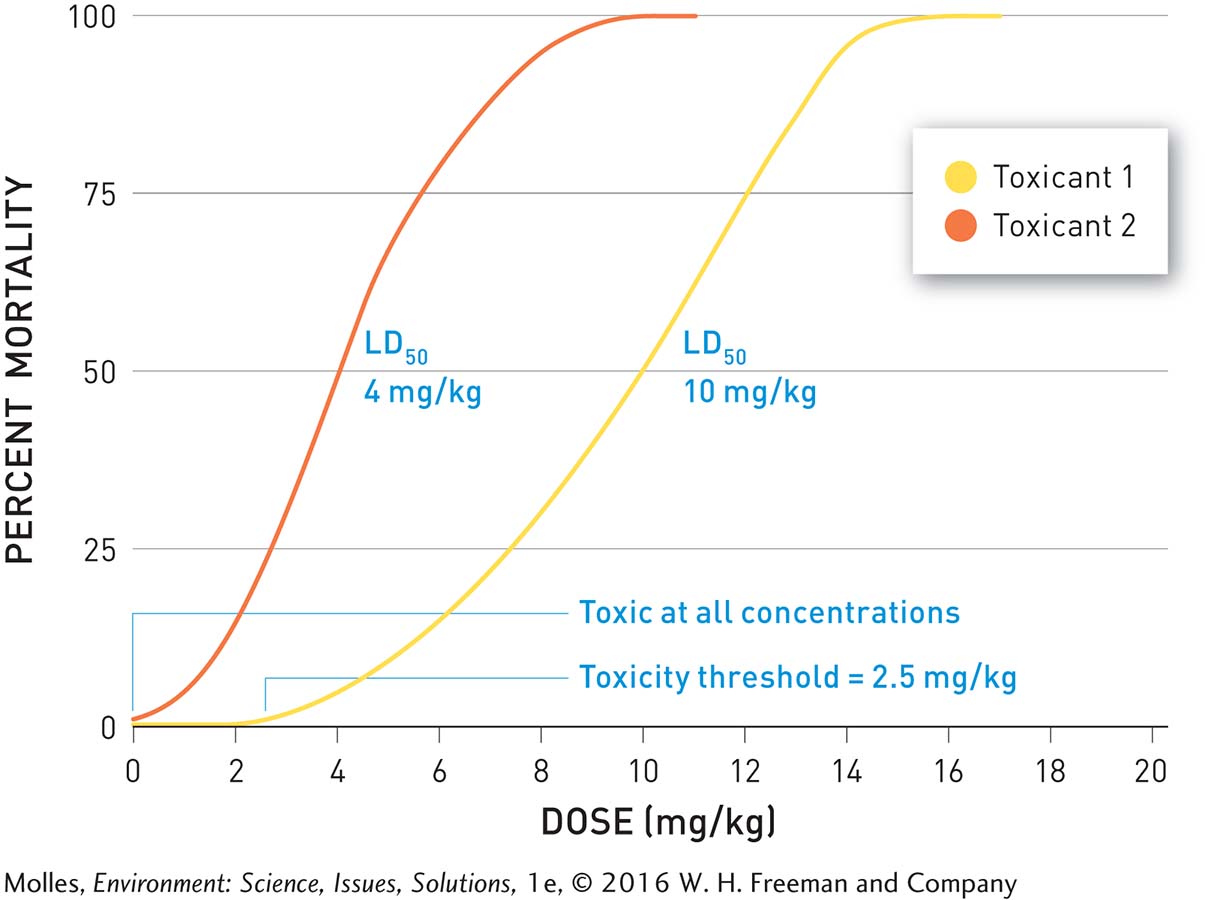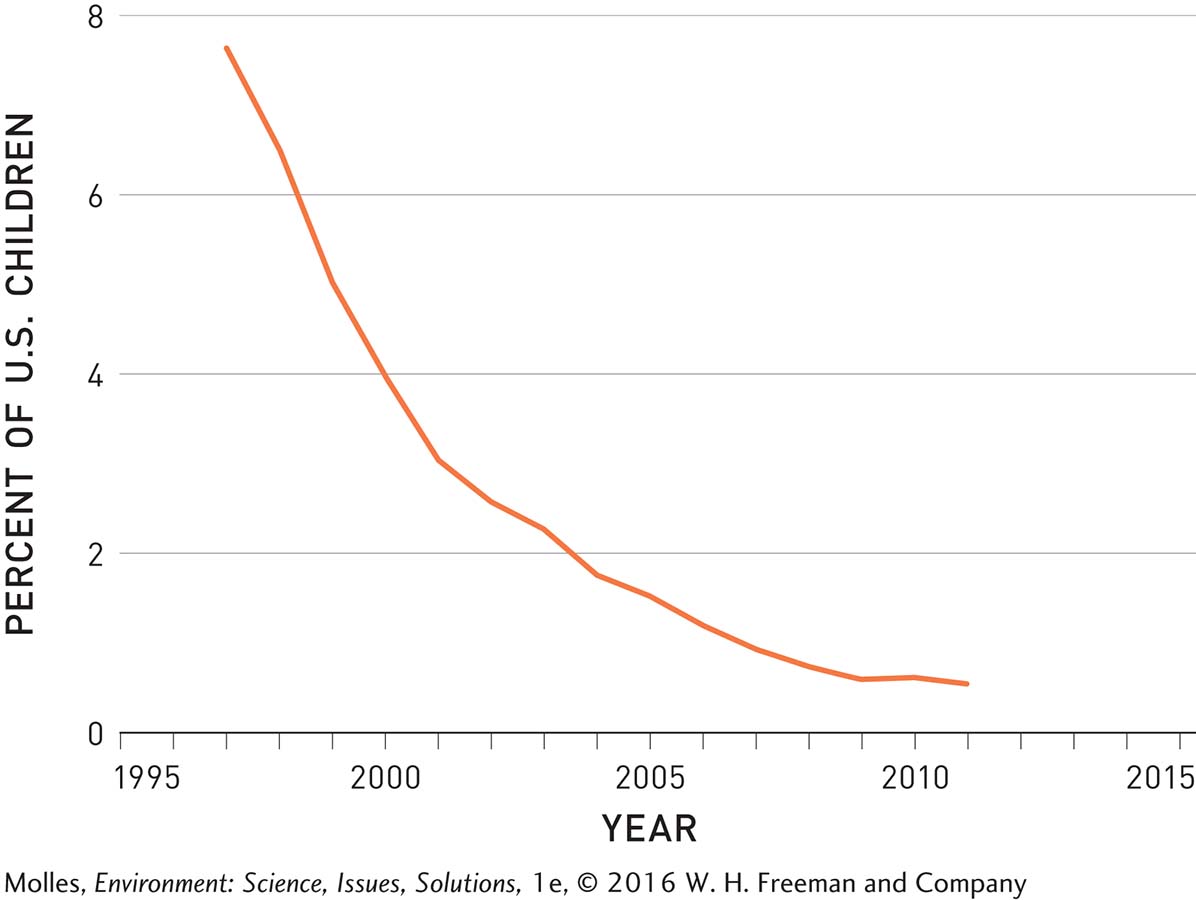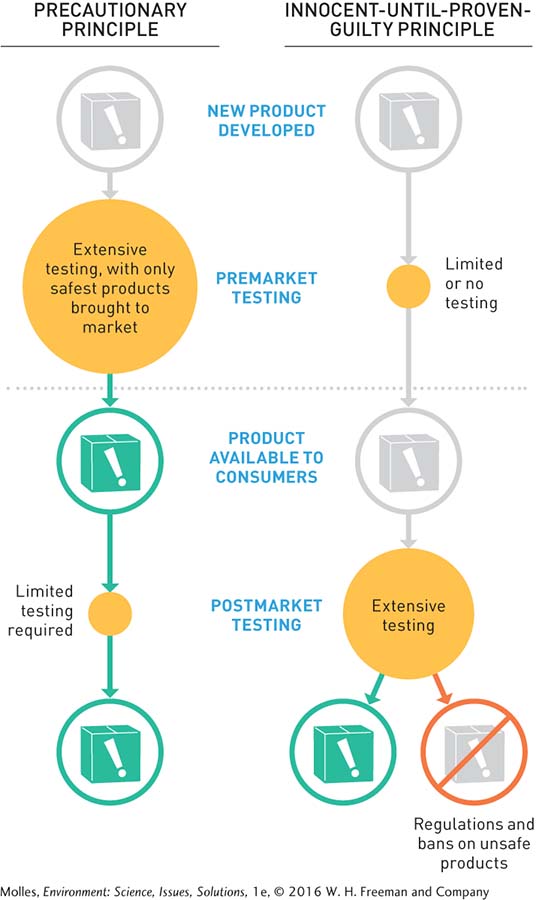11.7 We assess risk both qualitatively and quantitatively
11.7–
risk The chance of harmful effects to human health or to ecological systems resulting from exposure to any physical, chemical, or biological agent.
346
We have described a number of threats to environmental health, but how do we know how much of a risk each represents? While the word risk has many definitions, the EPA considers risk to be “the chance of harmful effects to human health or to ecological systems resulting from exposure to any physical, chemical, or biological agent that can induce an adverse response.” The practice of controlling infectious disease is fairly straightforward because the underlying causes of disease and antibiotic resistance are well understood. Solutions to problems related to toxic matter, in contrast, require a hard look at how much risk we are willing to tolerate.

Can risk be entirely eliminated from our lives?
Generally speaking, a risk is anything with the potential to cause us harm or loss or to put us in danger. How we assess risk in any given situation, however, will be influenced by our circumstances and the kinds of possible hazards we are considering. We evaluate a possible risk both qualitatively—
Risk Assessment Practices
In the 1970s, vinyl chloride gas—
The process of risk assessment became formalized with the National Academy of Science’s (NAS) groundbreaking report Risk Assessment in the Federal Government: Managing the Process. Since its publication in 1983, the EPA has integrated the principles of risk assessment into its practices and outlines four basic steps in the assessment of a potentially toxic substance: Identification of the hazard, dose–
1. Identification of the hazard. What health problems are caused by a given pollutant? During the first step of risk assessment, contaminants that are suspected to pose health hazards are identified. They are then tested to determine whether exposure may cause specific health problems (e.g., cancer, chronic disease) and whether the adverse health effect is likely to occur in humans. To obtain information for this step, existing scientific data for a specific chemical are evaluated. In addition, researchers may study populations that have been exposed to the chemical, or they may experimentally test the effects of the chemical on an animal (e.g., rats, mice, or monkeys).
dose–
threshold dose The lowest dose (concentration) of a toxic substance that induces a toxicity response in an organism.
2. Dose–
The most common type of dose–

exposure assessment An assessment of the population that might be exposed to an agent of concern and of potential routes of exposure.
3. Exposure assessment. How much of the pollutant are people exposed to over a given period of time? How many people are exposed? Exposure assessment defines the population that might be exposed to the agent of concern and identifies the routes through which exposure can occur. Exposure assessment also estimates the amount, duration, and frequency of the doses that people might receive as a result of their exposure.
347
risk characterization A qualitative or quantitative estimate of the likelihood that hazards associated with an agent of concern will negatively impact an exposed population.
4. Risk characterization. What is the extra risk of health problems in the exposed population? This is the step in which risk assessment results are articulated. It includes the analysis of information from the first three steps to develop a qualitative or quantitative estimate of the likelihood that any of the hazards associated with the agent of concern will occur in exposed people.
Assessment in Action
The EPA conducts risk assessments for a variety of agents, such as diesel exhaust, mercury, secondhand smoke, and ozone. The toxic metal lead is one such agent. Known to damage the nervous system, kidneys, and other internal organs, ingestion of lead in children can cause developmental delays or mental retardation. Since the 1980s, the EPA has phased out lead in gasoline and has banned or limited lead used in consumer products like residential paint. As a result, the levels of lead in the air have decreased by 94% between 1980 and 1999. The amount of lead in people’s blood has also decreased significantly in recent years. Of particular importance is the decrease in blood lead concentrations among U.S. children (Figure 11.17).

Furthermore, the EPA’s National Center for Environmental Assessment periodically evaluates the latest research concerning the public health and welfare effects of lead and publishes the most up-
Precautionary Approach Revisited
precautionary principle A principle advising that precautionary measures should be taken to protect human or environmental health, even if some cause-
Health and environmental regulations today are designed to keep the amount of a given contaminant released into the environment at a “safe” level, or to clean it up after it’s already entered the environment. New products and chemicals are often subjected to limited testing and assumed to be “innocent until proven guilty”—that is, until scientific evidence demonstrates them to be harmful. With this approach, it is possible for toxic chemicals to be released into the environment or into our bodies until sufficient evidence suggests that harm is being done. Instead of the assumption of safety, the precautionary principle (see Chapter 1, page 12) offers protection before harm is done—

How do we decide on the proper level of precaution to use when evaluating a new product that has the potential to both benefit and harm?


What levels of risk should be too high to allow the release or use of a toxic chemical?
In the 1992 Rio Declaration on Environment and Development of the Earth Summit, the precautionary principle was proposed in the context of protecting the environment. Principle 15 of the Rio Declaration states that “in order to protect the environment, where there are threats of serious or irreversible damage, lack of full scientific certainty shall not be used as a reason for postponing cost-
348
Some cities have successfully used the precautionary principle to guide policy. In 2005 San Francisco passed a purchasing ordinance that requires the city to use safer alternatives when purchasing commodities for the city, such as cleaning products or electronics. The idea is to minimize harm by using the best available science to identify safer, cost-
The precautionary principle is one useful tool to apply to environmental analysis and decision making, but it is not without its critics. Some say that regulation of products and chemicals could deprive society of significant benefits. In the United States, for example, the FDA requires all new drugs to be tested before they are put on the market. In other words, the FDA requires testing as a precaution to prevent harm to human health. Careful safety testing protects people from dangerous side effects, but it slows the introduction of new drugs. In the interest of precaution, the sickest of the sick may be prevented from receiving beneficial new medications.
The Exposome
One promising approach to studying how the environment impacts your personal health has been dubbed “the exposome.” The exposome consists of all the environmental exposures in an individual’s life and how those exposures affect that individual’s health. Because everyone is exposed to a wide range of pollutants, stresses, and other environmental variables, it has often been difficult to link a specific disease, say, a type of liver cancer, to a specific cause. Recently, researchers have begun measuring the exposome using a variety of high-
Think About It
Would it be possible for your school to implement the precautionary principle? If so, where could it do this?
What can individuals do to protect themselves from environmental contaminants?
What are the pros and cons of strict application of the precautionary principle in the development of new medications or other products?